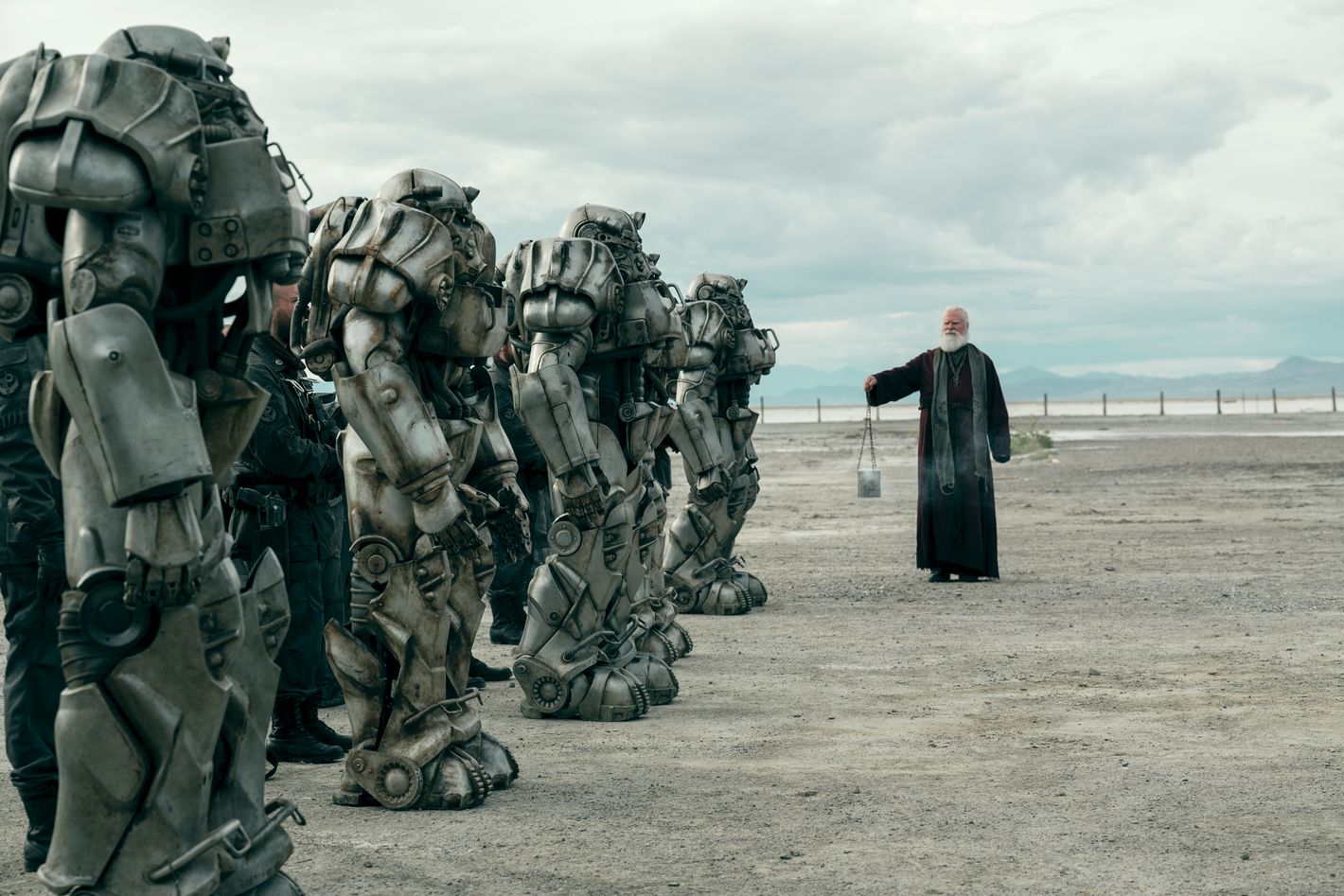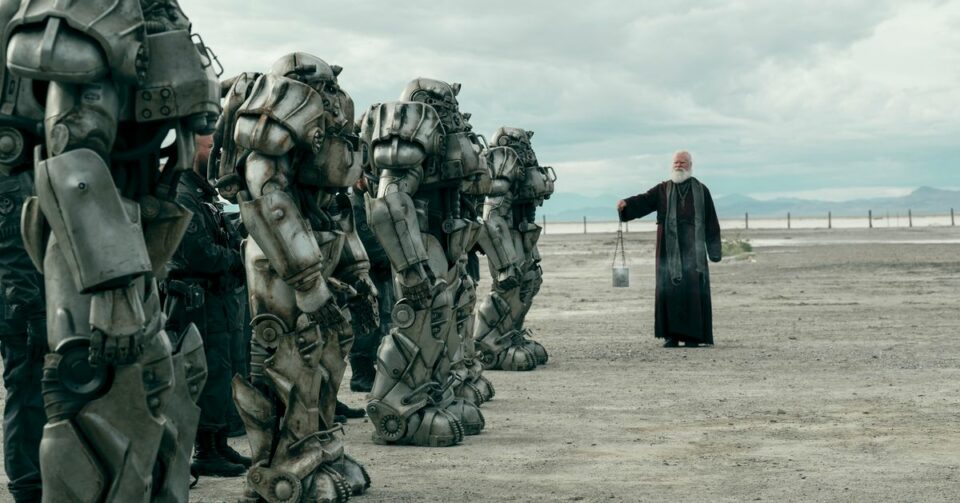
When Jonathan Nolan described the Fallout show as being about “what happens when you outsource the survival of the human race” on the press tour preceding its release, did anyone know to take him so literally? Sure, there have long been theories bandied around by fans about Vault-Tec’s involvement with the Great War. More broadly, tongue-in-cheek critiques of American commercialism, exceptionalism, and unfettered capitalistic greed are at the core of the series. And, after all, the nuclear exchange from which Fallout derives its name was started after a century of American gluttony and excess turned into war over the sparse resources that remained.
But, as it turns out, Nolan kind of gave us the conclusion to the plot — of this first season, at least — in a sentence. Here is, more than anything, a cautionary tale about monopolies, and giving one corporate entity too much unchecked power. (Streamed, no less, by Amazon.)
This is Fallout’s most poignant episode, as tragedies in the present collide with greater tragedies of the past, personal, and civilizational. It’s about a man who became a monster, haunted for 200 years by a betrayal that, quite literally, ripped the world apart; it’s about a father who committed a monstrous act for what he thought was the greater good; it’s about a daughter whose entire world view is shattered by revelations too painful to countenance. It’s about the cycles of violence and conflict we are doomed to repeat by human greed. “War never changes,” as Barb says, and the Ghoul painfully echoes, re-contextualizing Fallout’s famous tagline as curdled justification for corporate-sponsored genocide.
Goggins’s performance in the flashback scenes, as Cooper Howard listens to his wife drive the world towards annihilation, is staggering. Imagine it: The person you most admire, who you raised a daughter with, has been driven by the poisoned logic of corporate greed to murder everyone you know. You know you’ll be saved, but at what cost? We witness, here, Cooper’s first step on his path toward becoming the Ghoul. The first time his virtuous spirit is shaken. Cooper Howard was more like Lucy MacLean than the Ghoul would ever like to admit: He was an idealist, an optimist, a person who took people at face value. The bombs were a crucible that burned that away from him, but the process began before they fell, when he heard the words that would end the world coming from the lips of the person he loved most.
It’s heartbreaking. As is the finale’s other great revelation, after Lucy finally catches up to Moldaver at the Griffith Observatory — repurposed as a home base by the resilient remnants of the New California Republic — to find her dad locked up in an oversize bird cage. But, for Lucy, there’s more than just one family reunion: The rotting feral ghoul who sits at the dinner table with Moldaver is her mother. In Vault 31 below the surface, Norm discovers its role in the overarching mystery: It plays host to rows full of Vault-Tec junior executives frozen for centuries in cryopods, with the inhabitants of Vaults 32 and 33 used as breeding stock. Vault-Tec’s goal? To create a superior Vault-Tec approved race to recolonize the world — management.
Hank was one such junior exec, born before the bombs fell, just like Overseer Betty, and Stephanie, and every other dweller originally from 31. They were all part of a pre-war Vault-Tec training initiative led by Bud Askins, called “Bud’s Buds.” Oh, and Bud is the overseer of Vault 31 — well, Bud’s brain, suspended in a jar on a roomba.
The big reveal in the pre-war timeline takes place in a smokey executive suite lovingly evocative of Dr. Strangelove’s war room, in Vault-Tec HQ. It’s attended by the head honchos of all of Fallout’s major corporations, minus Nuka Cola: even Fallout: New Vegas’ Robert House makes a cameo as the representative for RobCo, the company that designs and manufactures the majority of the Fallout universe’s robots. (Go figure.) Barb brings them together to offer what is, essentially, the granddaddy of corporate mergers. “When we are the only ones left, there will be no one left to fight. A true monopoly,” she says. Vault-Tec will give them all vaults to conduct the experiments they please — and they’ll artificially bring nuclear war forward by dropping the bomb themselves.
From a fans’ perspective, the lore ramifications are huge. Not only is it now canonized that Vault-Tec started the Great War, but they did so as the U.S. and its nuclear rivals were seemingly on the precipice of a ceasefire. We also have a canonical explanation as to why so many of Vault-Tec’s vaults were set up with devilish experiments — so that each company could use the inhabitants of their respective vaults as lab rats.
Back in the present, Maximus brings the Brotherhood to the Griffith Observatory in the hope of saving Lucy. (It’s also revealed that Aspirant Dane sliced open their own foot in the first episode because they were afraid of being deployed to the wasteland.) The Brotherhood fall on the settlement like a hammer of steel, massacring its meager flesh-and-blood defenders from behind the safety of their power armor. It’s almost a complete rout.
In the main room of the Griffith Observatory comes a series of painful revelations for Lucy; firstly, Hank was born before the war. But then Moldaver, who is hardly innocent herself — she may understandably hate Vault-Tec, but let’s not forget that she led an army of raiders to murder the innocent inhabitants of a vault — reveals that Hank was the one who destroyed Shady Sands. Why? Because a Vault-Tec employee can’t stand by idly while civilization rebuilds itself without them. Further, it’s implied that the nuclear detonation led to the ghoulification of Lucy’s mother. “That’s how Vault-Tec deals with competition,” Moldaver says. “Just like they did 200 years ago.”
The emotional weight combines to leave Lucy in a fugue state, staring blankly as Maximus enters the room. Hank uses the confusion to his advantage, and gets the Brotherhood man to free him, before stealing a suit of power armour and knocking Maximus out.
Not that Hank is able to escape scot-free. Entering the fray after cinematically dispatching a room full of tin-can Brotherhood soldiers, The Ghoul shoots Hank in the face, at least leaving him with a hell of a scar. The Ghoul knew Hank when they were Cooper Howard and Henry; Henry used to pick up Barbs’ dry-cleaning. “I’ve waited over 200 years to ask somebody one question,” The Ghoul says, raising his hand cannon. “Where’s my fuckin’ family?” It bears repeating that the Ghoul and Lucy have always had more in common than they’d like to admit. And Cooper Howard is still in the Ghoul, somewhere.
After Hank runs away, The Ghoul offers Lucy a choice: Either stay with Maximus’s unconscious body and be killed by the Brotherhood when they arrive or come with him to find her dad. (So, yeah, back to square one.) Reluctantly, and with the fantasies of her life with Maximus back in Vault 33 at the back of her mind, Lucy leaves with the Ghoul. Just as they leave, they catch sight of the lights underneath the Hollywood sign starting up for the first time in two centuries. Back in the Observatory, with her dying breath, Moldaver has used the cold fusion chip from Wilzig’s head to bring power back to L.A.
As Cooper Howard watched the bombs fall on the city from the Hollywood Hills 200 years ago, captured in the first seven minutes of Fallout, newly anointed Knight Maximus, now awake, watches as the lights of the city return. And with them, optimism for a new, better world.
“What do you suppose your Brotherhood would do with infinite power,” Moldaver asks him. “Maybe you can stop them. Maybe you can’t. Maybe all you can do is try.”
In the meantime, some hundreds of miles to the North East, Hank — still in his T-60 suit — passes the skull of a death claw as he clambers up a sand dune. In front of him, the great jewel of the Mojave desert beckons: New Vegas, where answers, and certainly more questions, will present themselves. We’ll see you in season two.
Bottle Caps
• I don’t want to read too heavily into it, but the post-credits animation shows New Vegas in a state of disrepair — certainly not as the working oasis of hedonism we see in Fallout: New Vegas. Presumably, its economy faltered with the fall of the NCR and the end of its citizens’ steady stream of caps.
• Said post-credits animation has another little retcon: a billboard advertising “cryosuites” at the Tops Casino and Hotel, which was not present in New Vegas.
• I can’t wait for Mr. House — one of the best-written characters in Fallout altogether — to presumably play a bigger role in season two. If you’ve not played New Vegas, you’re in for a treat.
• The final song in the series is a fitting one: “We Three” by the Ink Spots, heard in Fallout 76, per Google. (76 is the only Fallout mainline title I’ve not played, but I hear it’s good nowadays.)
• The Hollywood sign being sponsored by Nuka Cola is an excellent last little fan-centric gag in a series replete with fan-centric gags.
• Thanks for reading the recaps, wastelanders. It was a pleasure to be your guide. One last public-service reminder: Don’t feed the Yao Guai. That is all.
Jack King , 2024-04-12 21:34:53
Source link

